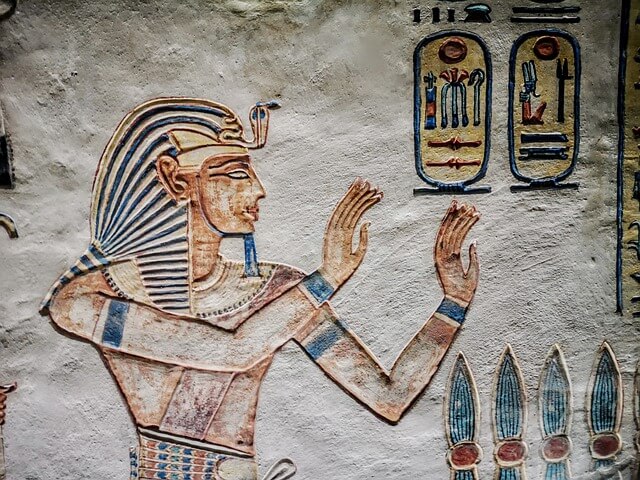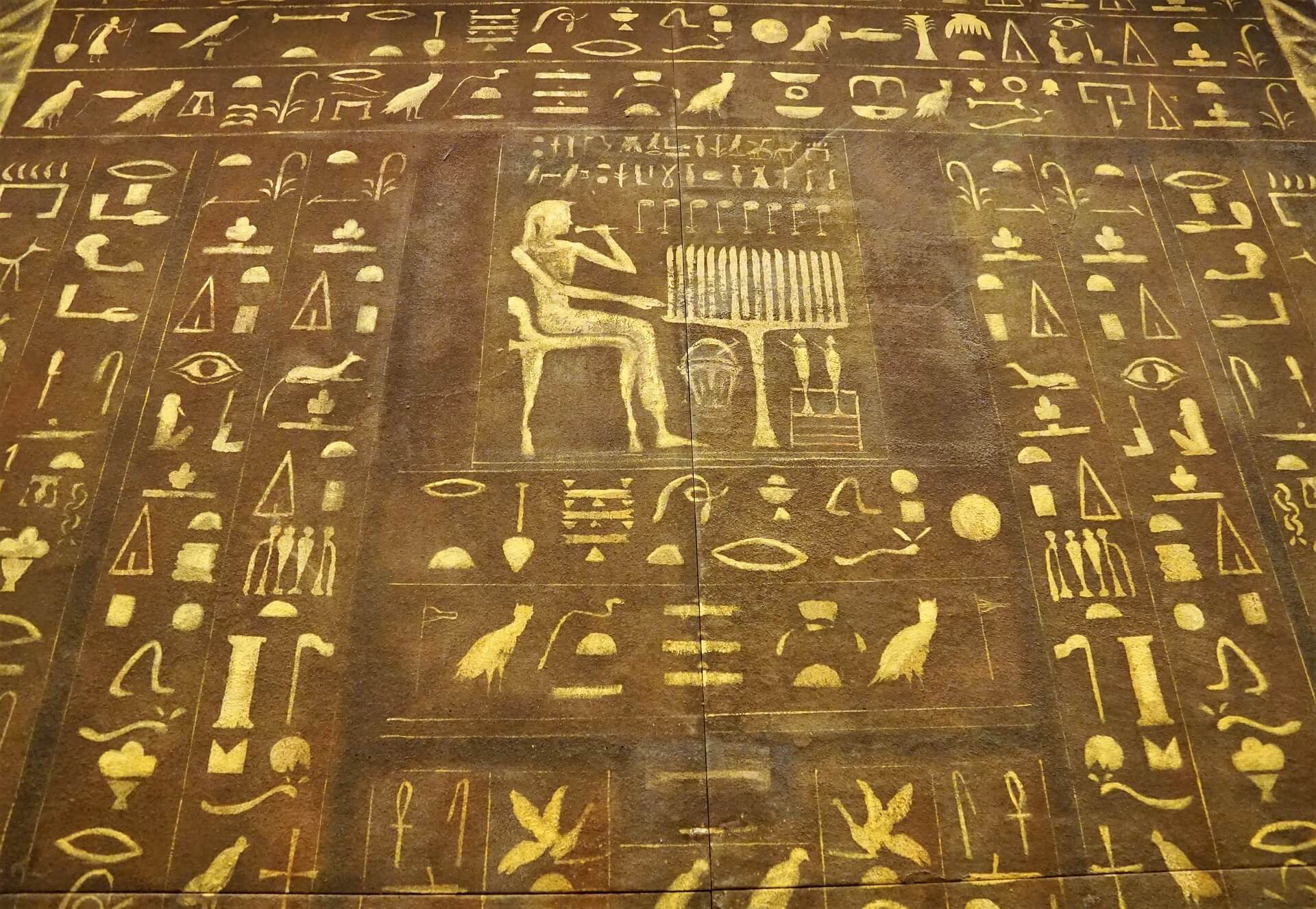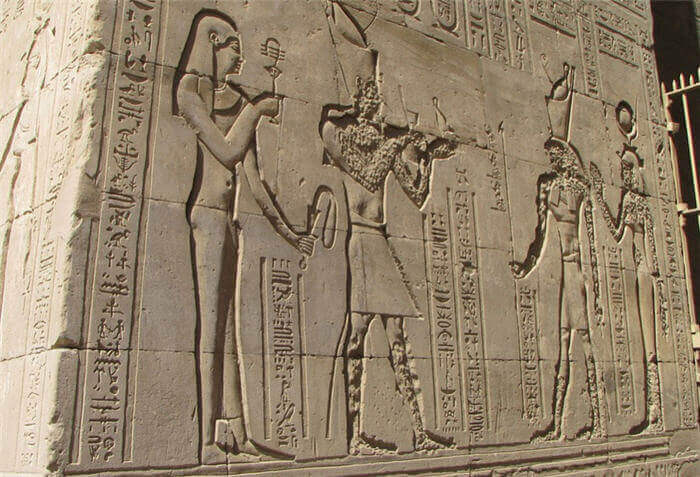The people of ancient Egypt were totally dependent on the Nile River for their livelihood.
To the Egyptians, their country was the “Black Land,” a name that refers only to the narrow strip of fertile land, the valley and delta of the Nile, separating two deserts.The advantages of the valley early encouraged prehistoric man to abandon his nomadic life and settle on the banks of the Nile. There, despite the rainless climate and harsh summer heat, it was easy to grow Crops and graze animals after the river’s annual inundation had deposited its layer of moist, fertile silt. The flood, which begins in June and reaches its peak in September, is followed by warm, sunny winter months.

Source : pixabay.com
Population and Agriculture.
Plentiful food supported a growing population, which in turn required ever more agricultural land. Estimates of the population of ancient Egypt vary, but during the great periods of Egyptian civiiization there may have been about 2 million inhabitants. The fertile region was not overpopulated, although it was densely populated for maintaining an agricultural society at the existing level of technology. From very early times cooperation among men was neeessary to build and maintain the dikes that protected settlements from the annual flood and also contained water in large basins for irrigation.
The principal grains produced by the Egyptians were barley and emmer, a variety of wheat. Flax was cultivated for making linen. Date palms and fig and other fruit trees were kept, and vineyards were worked. Livestock raising was a major occupation, and the animals kept included not only easily domesticated cows, oxe», sheep, goats, and pigs, but also ibexes, oryxes, gazelles, and other wild animals. Fİocks of ducks, geese, pigeons, and pelicans were tended, and bees were kept for honey and wax.
Natural Resources.
The greatest mineral resource of ancient Egypt was probably gold. Egypt and Nubia both produced it in great quantities, and the Egyptians soon learned to appreciate the soft, decorative metal. Most ancient peoples were impressed by Egypt’s wealth in gold, and whatever else the country lacked could be purchased with it. Kings, especially in the New Kingdom, often hoarded gold and not only had the mines worked steadily but also imported gold and demanded it as tribute. Gold was also used to aid foreign allies.
Other, more useful metals were not plentiful in Egypt. Copper was used very little in prehistoric times, and even in the early dynastic period it was employed more for decoration than utility. By the time of the Old Kingdom, copper was used for tools and weapons. It continued to be used until bronze was introduced from Asia in the Middle Kingdom. Iron was known and used for some artifacts at an early date but was not employed extensively until the 26th dynasty.
The most abundant and best-used resource was stone. Egypt had numerous quarries that provided the materials for its monumental buildings and statuary. Most of the cliffs of the Nile Valley are limestone, and this material was used extensively in ali the historic periods. New Kingdom temples built after the reign of Hatshepsut, however, were made of sandstone, which came from the very south of Egypt, chiefly from Gebel Silsila. The best granite came from Aswan and was used from early dynastic times. To a lesser extent alabaster or calcite from Middle Egypt, graywacke from the Wadi Hammamat, and basalt from the Faiyum were also used for building and sculpture. For the walls of dwellings and of storage buildings, mud brick was adequate in a nearly rainless country like Egypt.

Source : pixabay.com
Trade and Transportation.
The picture of Egypt’s foreign trade is somewhat unclear because most of the goods imported were regarded as tribute—what was due the Egyptian kings and gods. Hence there is little record of what was given in exchange. Certainly real tribute was exacted at times, but much that was called tribute was probably paid for with gold. Egypt lacked wood and throughout the historic periods imported coniferous wood from Lebanon, Ebony and ivory were regularly imported from Cush (Kush) to the south. Rarer luxuries included silver from Syria and the Aegean islands and myrrh from Punt. In addition to gold, Egypt probably exported linen, leather, grain, and papyrus. Trading was by barter, although in many cases value was expressed in terms of sacks of grain or weights in gold, silver, and copper.
To conduct its foreign trade, Egypt had special ships for the Mediterranean voyage to Byblos, in Lebanon, and also for the Red Sea voyage to Punt. Transportation within Egypt was almost exclusively by water, and it was simplified by a prevailing north wind that enabled ships to sail upstream on the Nile.
Labor Force.
The whole land of Egypt belonged to the king, and thus most of the economy was based on service to him. He could and did, of course, grant the use of his land to both temple priesthoods and private individuals, but even they were seldom immune from the burden^ of taxes and service. Although some private property existed, it was subject to the king’s will.
The power of the king also had a tremendous effect on the labor force within the country: it determined to a large extent the type of employment available, and the king was able to conscript any number of people for certain large-scale works. Through the corvee, or labor levy, not only were dikes maintained and crops harvested, but very likely the pyramids and temples were erected. Almost ali occupations, from scribes and artists to farmers and fishermen, either served the palaces or temples directly or served those who did. Thus shoemakers, cooks, brewers, and water carriers served those who administered the royal and temple estates or projects, and even skilled workmen were generally satisfied to be paid in food and clothing.

Greek and Roman Periods.
In the Ptolemaic Period an elaborate system of state monopolies existed, and regular coinage was introduced, together with a very modern banking system. In the Roman Period, private ownership of land was encouraged, to provide both a tax base and a guarantee of productivity, for insufficiently productive property could be confiscated. Irrigation was improved and harvests increased, so that Egypt became the “granary of Rome” and the helpless victim of Roman exploitation.